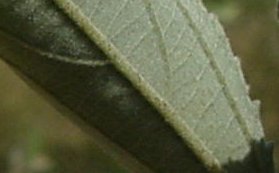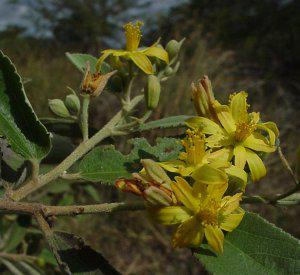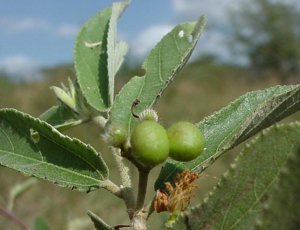Grewia bicolor
Grewia bicolor Juss.
Family: Malvaceae
Common names: white raisin (Eng.); witrosyntjie (Afr.); umsiphane (Swazi); nsihana, guguna, nsihani (Tsonga); mogwane (Tswana); murabva (Venda); umlalampunzi, imdliwampunzi (Zulu).
SA Tree No: 458
Introduction
The bicoloured-leaved Grewia bicolor has beautiful, bright yellow flowers. It is a frost-resistant, hardy shrub or small tree that is adaptable to all soils, from clay to sand, and does not require much water.

Description
Description
Grewia bicolor is a multi-stemmed shrub or small tree, up to 9 m high. Its bark is smooth, grey, becoming dark grey and deeply fissured and peeling away in straps with age. The young branchlets are velvety grey or brown.
The leaves are alternate, simple and elliptic to slightly ovate, 15-80 x 10-32 mm, with a broadly tapering to rounded apex. They are 3-veined from the asymmetrically lobed base, rounded to slightly cordate, held horizontally or drooping, glossy green above, almost white and silvery hairy below, while the margins are entire to slightly serrated. The petiole (leaf stalk) is about 1-8 mm long.

The flowers are small, bright yellow, borne in axillary clusters at the end of branches. They are often borne in profusion, with sepals up to 12 mm long and petals shorter. The flowering time is October-March.

The fruits are round and fleshy drupes (fruits such as plums), reddish brown or orange and black when ripe, entire or deeply 2-lobed, up to 6 mm in diameter.

Conservation Status
Status
According to Raimondo et al. (2009), Grewia bicolor was of Least Concern (LC), when it was evaluated against the five IUCN criteria, as it does not qualify for the categories Critically Endangered, Endangered, Vulnerable or Near Threatened.
Distribution and habitat
Distribution description
Grewia bicolor naturally occurs in dry deciduous woodland and bushveld. It is frequently associated with mopane at low altitudes, on sandy flats and rocky mountain slopes. It is also occasionally found at medium altitudes in higher-rainfall areas. It is widespread, from northern KwaZulu-Natal to West Africa, Ethopia and Angola, also the Middle East and India.
Derivation of name and historical aspects
History
The genus Grewia was named after Nehemiah Grew (1641-1712), an English physician. The specific name bicolor refers to bicoloured leaves.
Ecology
Ecology
The white raisin is often associated with termite mounds and riverine fringes, especially at medium altitudes in higher-rainfall areas.
Uses
Use
The bark of this Grewia is used for fibre, and the wood for axe handles and sticks. The leaves are browsed by game and livestock. The fruit is edible, sweetish but astringent. The roots are also used to treat chest complaints.
Growing Grewia bicolor
Grow
Grewia bicolor is a most variable species, probably because it freely hybridises with G. monticola to produce a fertile hybrid under the name G. subspathulata. These trees grow best in temperate climates with summer rainfall. They do not require much water and are frost-hardy. Grewia bicolor forms a distinct shrub layer below the tree canopy.
References
- Boon, R. 2010. Pooley's Trees of eastern South Africa: A complete guide , edn 2. Flora & Fauna Publication Trust, Durban.
- Coates Palgrave, M. 2002. Keith Coates Palgrave Trees of southern Africa , edn 3. Struik, Cape Town.
- Raimondo, D., Von Staden, L., Foden, W., Victor, J.E., Helme, N.A., Turner, R.C., Kamundi, D.A. & Manyama, P.A. (eds). 2009. Red List of South African plants 2009. Strelitzia 25. South African National Biodiversity Institute, Pretoria.
- Schmidt, E., Lötter, M. & McCleland, W. 2002. Trees and shrubs of Mpumalanga and Kruger National Park. Jacana, Johannesburg.
- Van Wyk, A.E., Van den Berg, E., Coates Palgrave, M. & Jordaan, M. 2011. Dictionary of names for southern African trees: Scientific names of indigenous trees, shrubs and climbers with common names from 30 languages , edn 1. Briza Publications, Pretoria.
Credits
Mothogoane M.S.
National Herbarium, Pretoria
September 2012
Plant Attributes:
Plant Type: Tree
SA Distribution: Gauteng, KwaZulu-Natal, Limpopo, Mpumalanga, North West
Soil type: Sandy
Flowering season: Early Summer, Late Summer
PH: Neutral
Flower colour: Yellow
Aspect: Shade, Morning Sun (Semi Shade), Afternoon Sun (Semi Shade)
Gardening skill: Average
Special Features:
Horticultural zones









Rate this article
Article well written and informative
Rate this plant
Is this an interesting plant?
Login to add your Comment
Back to topNot registered yet? Click here to register.